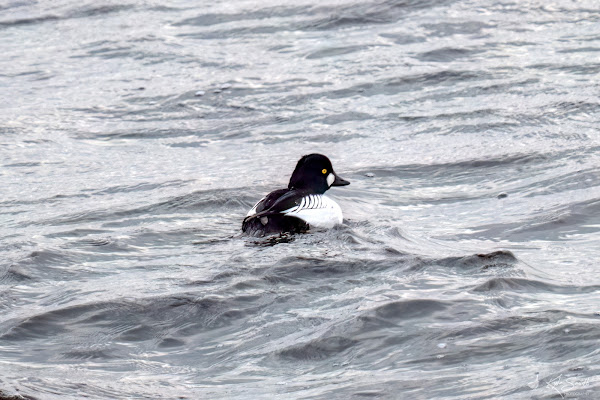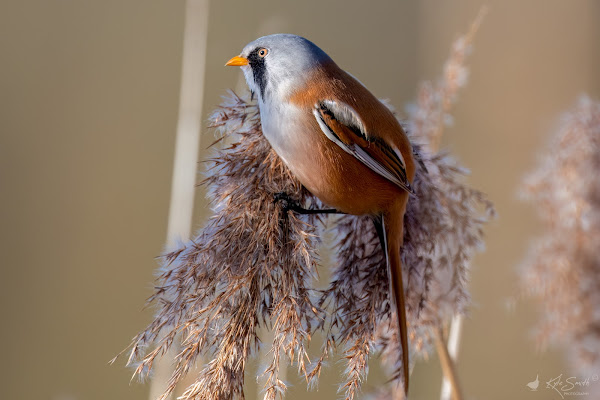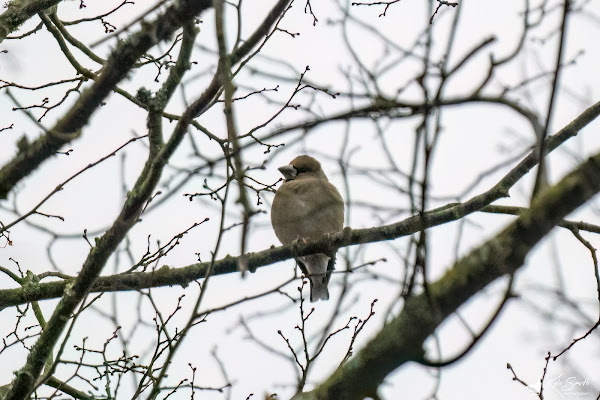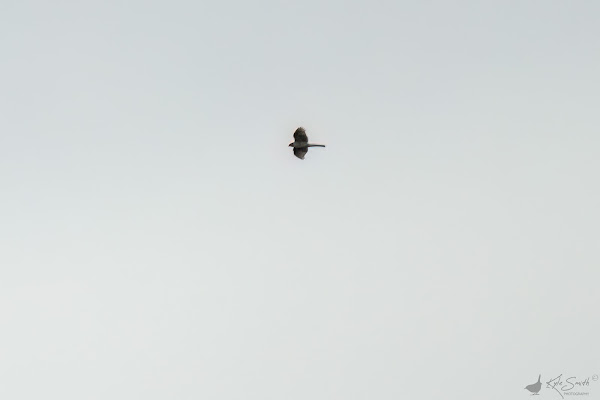Kev Heath (@kev07713) and I arrived at Staines Reservoir, stopping for breakfast on the perimeter road. As we climbed into the car a single ring-necked parakeet flew over (year tick) - how many of these would we see today!, they are now prolific across the capital. We pulled up in a layby by a track that leads up to the causeway, off the main road running between Staines Reservoir and the King George VI Reservoir. It was grey and a stiff breeze blew (roughly from the north) which made us think that the birds on the water may take shelter on the northern end below the protection of the causeway - wrong. There were a number of wigeon, coot, goldeneye and teal but the majority of the ducks were at the southern (inaccessible) end. Scanning through the ducks by the causeway, we came across a lone black-necked grebe swimming in the line of wigeon - it broke off and made its way left and further out - a record shot is all we would get.
Kev set up his scope and we scanned distant ducks, sleeping on the water and water’s edge of the concrete bowl - later I would measure the distance and they were ½ mile away! We picked out the lesser scaup in amongst the pochard and despite the distance and with only line of sight to go by, I took some photos - amazingly (with a bit of cropping) I had a record of the bird.
Did you see it? ... Kev heard a pipit go across that he was convinced was not a meadow pipit, but it was lost from view. Soon I strolled along the causeway to see what I could find - I came across a couple of meadow pipit and then in the distance a water pipit; before I could get a photo it was up and away, heading back down the causeway to Kev - I called him on WhatsApp but he had his phone on silent accidentally. The bird kept flying through and onto the western bank, but I didn't see it land. I worked further along spotting further mipitsand returned to where Kev was still stationed.
When I got to Kev he decided to do the same as me and called to say there was a light bird flitting ahead of him but when we got views it was only a very pale (white almost) mipit.
We scanned constantly to see if we could find anything else but it was only when we were walking to leave a single linnet dropped onto the fencing.
We arrived at WWT London Wetlands at Barnes and instantly heard the call of parakeets. It didn't take until we had eyes on them, in trees and on the Visitor's Centre. They are amazing birds to be seeing in the wild - we have a few in Banbury but the population in London has exploded. The birds on the Visitor's Centre were particularly interested in our comings and goings - they appeared to be hanging around nest holes in the bricks.
We headed out over the reserve and scanned the water but there was nothing unusual about - the water pipit and bittern didn't make a show. We overtook a mute swan on the path and stopped hoping to see one of the calling Cetti's warblers but with no luck. It was an enjoyable visit but not much to excite. We stopped for lunch and made a plan of action - we'd head home but drop into RSPB Otmoor on the way.
As we left, we found a couple of pairs of parakeets showing the love.
We arrived at Otmoor and found the car park relatively busy but with a few spaces remaining. We scanned as we made for the bridleway but with nothing notable to report, although with significant numbers of golden plover on the ground. Marsh harriers cruised across Greenaways and beyond and on setting off along the bridleway I picked out the visiting black swan as it took to the air and departed. A good-looking bird with great white wing feathers - not sure I've ever seen one in flight before. We stopped to watch kestrels hunting and multiple marsh harriers passing low through Big Otmoor. This set up golden plovers and lapwings on a regular basis and was a fantastic spectacle.
We heard calls from Cetti's warblers and water rails but couldn't lay eyes on them - no surprise there. We stopped to talk with another birder and waited to see if the bittern would grace us with a view - as we talked a sparrowhawk snuck along below the height of the reeds along the ditch between us an Greenaways, eventually cutting across and behind the reeds beyond. There were a couple of curlews feeding in the far grassy fringes of Greenaways and we saw further distant passes of marsh harriers. Things are hotting up and the harriers seemed more active than recent visits. The chap we were talking to mentioned he had seen a ringtail hen harrier from the bridleway earlier - we had no repeat and made our way back to the car and home.
On Sunday morning Kev was to travel with two Karens (wife and sister) and sister Karen's partner Dean to Conway for a spot of sea watching - I had some things to do and made do with an early trip to Stanwick Lakes to see if I could see the bearded tit. I've been trying to get a decent photo (in fact any) of this species for over a year and failed to date so was really keen to have a go - reports suggested the bird showed well and reasonably regularly, although took until mid-afternoon to appear on Saturday.
I reached the "green causeway" and the area that the bird has been seen regularly. There was one birder already walking the causeway but relayed that he had neither seen nor heard the bird so far. I decided to work the redds along the causeway and it was only 20m further on that I turned to see the bird feeding atop the reed seed heads. I snapped a couple of shots and called the other birder to come and join me. Gradually others joined until we were about 10 in number. The bird took no notice of us and was happy to feed with us all close and observing - to say it was showy was a massive understatement.
Craig Churchill (Instagram @craigchurchillphotography) arrived and I recognised him from a visit to see brambling at Banbury Ornithological Society's Balscote Quarry Reserve. He remembered me too and chatted as we marvelled at how close the bird was showing. Having been afforded great views I had to depart and head home and get some household chores done before starting the new working week.
Year List: 143























































